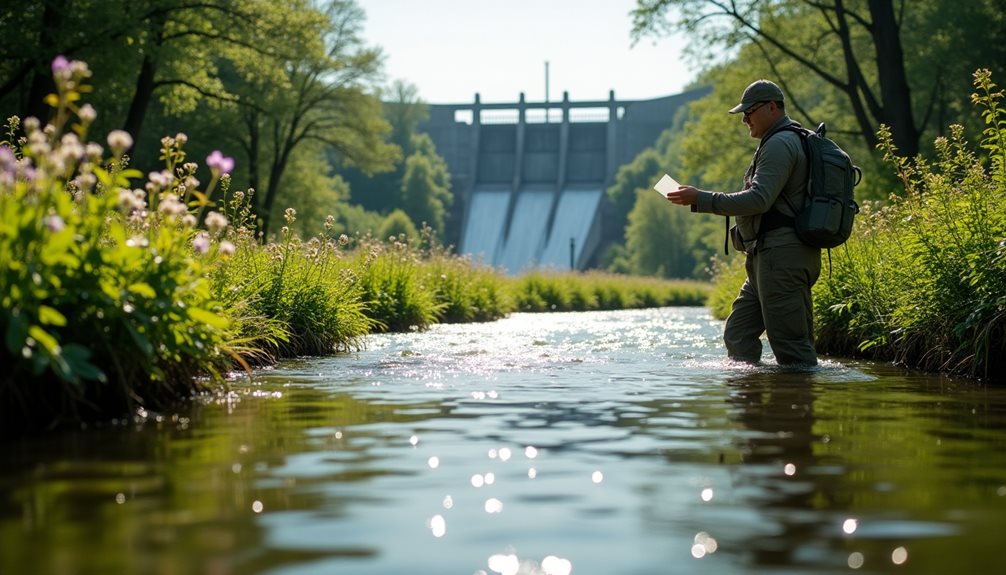Table of Contents
ToggleImportance of Water Conservation

As the global population continues to grow and climate change exacerbates water scarcity, the importance of water conservation has become increasingly evident. Effective water conservation strategies are essential in addressing the urgent need for sustainable water management.
Implementing water scarcity solutions not only preserves critical resources but also mitigates the adverse effects of droughts and pollution. Furthermore, environmental education plays a pivotal role in fostering awareness and promoting responsible water use among communities.
![]()
Key Terms in Water Resources Management
Understanding key terms in water resources management is essential for effective communication and implementation of strategies aimed at conserving water. Knowledge of specific terminology enhances comprehension of conservation strategies, allowing stakeholders to collaborate more efficiently.
| Russian Term (Cyrillic) | Phonetic (English) | English Definition |
|---|---|---|
| Водоносный слой | Vodo-nos-nyi sloi | Aquifer – underground layer of water-bearing rock |
| Устойчивое использование | Ustoichivoe ispol’zovanie | Sustainable use – using resources without harming future availability |
| Интегрированное управление | Integrorovannoe upravlenie | Integrated management – coordinated approach managing water resources |
| Водный след | Vodnyi sled | Water footprint – amount of water used for production and consumption |
Familiarity with these key terms empowers individuals and organizations to engage in meaningful dialogues about water resource management and fosters a collective commitment to conservation.
![]()
Russian Vocabulary for Water Quality (Словарь по качеству воды)
Water quality plays an essential role in public health, ecosystem stability, and sustainable resource management. In Russian, understanding the terminology related to water quality is crucial for effective communication and action.
The term “качество воды” (kachestvo vody) refers to the overall condition and safety of water, encompassing various parameters such as chemical composition, biological factors, and physical properties. Additionally, “питьевая вода” (pit’evaya voda) specifically denotes drinking water that meets health standards.
Knowledge of these terms enables individuals and organizations to assess water safety, advocate for conservation practices, and engage in policy discussions. As awareness of water quality issues grows, a solid grasp of this vocabulary empowers communities to pursue healthier environments and improve public health outcomes through informed decision-making.
Water quality is a critically important topic that affects public health, environmental balance, and the sustainable use of natural resources. In Russian, understanding the specific terms related to water quality helps people communicate clearly about water safety, pollution, and conservation efforts.
Key Russian Terms and Their Meanings
- Качество воды (kachestvo vody) — water quality
This term means the overall state or condition of water. It includes chemical makeup (like minerals or harmful substances), biological factors (such as bacteria or algae), and physical properties (color, clarity, temperature). Assessing качество воды involves tests to see if the water is safe for drinking, agriculture, industry, or ecosystem survival.
- Питьевая вода (pit’evaya voda) — drinking water
This refers to water that is safe and suitable for human consumption. It must meet strict health standards set by government regulations to ensure it is free from harmful microorganisms, toxic chemicals, and unpleasant tastes or smells. Clean питьевая вода is essential for preventing diseases.
Why Understanding Water Quality Vocabulary Matters
Knowing these words helps people in many ways:
- Public Health: Understanding terms like качество воды and питьевая вода allows individuals to recognize when water might be unsafe and take precautions to avoid illness.
- Environmental Protection: Terms related to water quality help communities monitor pollution and advocate for cleaner water sources.
- Resource Management: Effective communication about water quality supports sustainable use of rivers, lakes, and groundwater.
- Policy and Education: Clear vocabulary aids in discussing regulations, educating the public, and making informed decisions about water conservation.
Additional Important Terms Related to Water Quality
- Загрязнение воды (zagrjaznenie vody) — water pollution
Refers to the presence of harmful substances in water that degrade its quality.
- Химический состав (khimicheskiy sostav) — chemical composition
The types and amounts of chemicals found in water.
- Биологические факторы (biologicheskiye faktory) — biological factors
Living organisms in water, such as bacteria, algae, and parasites.
- Физические свойства (fizicheskiye svoystva) — physical properties
Characteristics like temperature, color, turbidity (cloudiness).
- Очистка воды (ochistka vody) — water purification
The process of removing contaminants to make water safe for use.
Summary
In Russian, the phrase качество воды describes the overall safety and condition of water, while питьевая вода specifically means safe drinking water. Mastering this vocabulary is essential for anyone working in health, environmental science, or resource management. It supports better understanding, discussion, and action toward keeping water sources clean and safe for all.
Terms Related to Water Supply and Distribution
The management of water resources extends beyond quality assessment to encompass the supply and distribution of water. Effective water distribution systems are vital for guaranteeing that communities receive adequate resources. Supply efficiency is imperative in minimizing waste and optimizing usage.
| Term | Definition | Importance |
|---|---|---|
| Water Distribution | The process of delivering water to consumers | Guarantees equitable access |
| Supply Efficiency | The effectiveness of water usage | Reduces wastage and conserves resources |
| Infrastructure | Systems facilitating water flow | Essential for reliability |
| Demand Management | Strategies to optimize water use | Balances supply and demand |
| Conservation Techniques | Methods to save water | Promotes sustainability |
Understanding these terms fosters a deeper appreciation for the intricate systems that support water availability and encourages responsible use.
Understanding Water Pollution Terminology
Pollution considerably impacts water quality, making it essential to grasp the terminology associated with this critical environmental issue. Understanding water pollution is crucial for effective management and conservation efforts.
The terminology importance cannot be overstated, as it aids in communicating the complexities of this challenge. Key terms include:
- Point Source Pollution – Contaminants released from a single identifiable source.
- Non-Point Source Pollution – Diffuse contamination arising from multiple sources, often carried by rainfall.
- Eutrophication – Nutrient over-enrichment in water bodies leading to excessive plant growth and oxygen depletion.
- Biodegradable Pollutants – Substances that can be broken down by natural processes, reducing their environmental impact.
![]()
Concepts of Water Sustainability

Sustainability in water resource management entails a careful balance between usage and conservation to ascertain that future generations have access to clean and sufficient water supplies.
The implementation of sustainable practices is essential to ascertain efficient water usage while minimizing environmental impact.
Water distribution is a key topic when learning about how water is delivered and managed. Understanding the vocabulary related to water systems can help English speakers learning Russian talk about these topics more confidently.
Key Concepts Expanded
1. Water Distribution (Распределение воды)
This means delivering water from sources like rivers, lakes, or reservoirs to homes, businesses, and farms. The goal is to make sure everyone has fair access to water.
2. Supply Efficiency (Эффективность поставок)
This refers to how well water is used without being wasted. Efficient water use means less waste and more saved for future needs.
3. Infrastructure (Инфраструктура)
These are the physical systems like pipes, pumps, and treatment plants that make water delivery possible. Without good infrastructure, water supply would be unreliable.
4. Demand Management (Управление спросом)
This includes strategies to control how much water people use, so supply and demand stay balanced. For example, encouraging people to use less water during droughts.
5. Conservation Techniques (Методы сохранения)
These are methods or practices to save water, such as fixing leaks, using water-saving devices, or recycling water.
Related Russian Terms Table
| Russian (Cyrillic) | English Phonetic | English Definition |
|---|---|---|
| Распределение воды | Raspredeleniye vody | Water distribution |
| Эффективность поставок | Effektivnost postavok | Supply efficiency |
| Инфраструктура | Infrastruktura | Infrastructure |
| Управление спросом | Upravleniye sprosom | Demand management |
| Методы сохранения | Metody sokhraneniya | Conservation techniques |
| Водопровод | Vodoprovod | Water supply system / pipeline |
| Водозабор | Vodozabor | Water intake / abstraction |
| Водоочистка | Vodoochistka | Water purification |
| Ресурсы воды | Resursy vody | Water resources |
| Водный баланс | Vodny balans | Water balance (supply vs demand) |
This list covers important vocabulary that will help learners discuss water distribution and management in Russian clearly and correctly.
Engaging With Community Water Initiatives
Engagement with community water initiatives plays an essential role in fostering local stewardship of water resources.
By promoting active participation, these initiatives empower residents to take charge of their water management.
The following aspects highlight the importance of community engagement in water initiatives:
1. Education (Образование – Obrazovaniye)
Education is fundamental in raising awareness about water conservation (сохранение воды – sokhraneniye vody). When people understand how water cycles work and the impact of their daily actions, they make better choices. For example, learning about reducing water waste by fixing leaks or using water-efficient appliances can significantly lower household water use.
2. Collaboration (Сотрудничество – Sotrudnichestvo)
Collaboration among community members, local governments, and organizations (организации – organizatsii) fosters resource-sharing and innovative solutions. Joint efforts can include building rainwater harvesting systems or restoring local wetlands, which help recharge groundwater and improve water quality.
*3. Sustainability (Устойчивость – Ustoychivost’)*
Communities engaged in water management are more likely to adopt sustainable practices (устойчивые практики – ustoychivye praktiki). These practices ensure that water remains available not only for the present but also for future generations. Using native plants in landscaping, which require less irrigation, is an example of sustainability in action.
4. Advocacy (Адвокация – Advokatsiya)
Community-led initiatives can influence policy (политика – politika) changes at local and regional levels. When citizens come together to voice concerns or propose solutions, they can push for laws that protect water sources, regulate pollution, or fund infrastructure improvements.
Additional Benefits of Community Water Engagement
- Resilience (Устойчивость к трудностям – Ustoychivost’ k trudnostyam): Communities that manage their water actively are better prepared to face droughts, floods, or contamination events.
- Economic Savings (Экономия средств – Ekonomiya sredstv): Efficient water use reduces utility bills and lowers the costs of water treatment.
- Social Cohesion (Социальное единство – Sotsialnoye yedinstvo): Working together on water issues strengthens community bonds and encourages collective problem-solving.
By fostering education, collaboration, sustainability, and advocacy, community engagement ensures that water resources are preserved and responsibly managed. This collective effort is vital for maintaining healthy environments and resilient societies.
Through these efforts, communities not only preserve their water resources but also strengthen their resilience against future challenges.
Active involvement in community water initiatives plays a crucial role in promoting local stewardship of water resources (водные ресурсы – vodnye resursy). These initiatives encourage residents to take responsibility for managing and protecting their water supplies, leading to healthier ecosystems and stronger communities.
Frequently Asked Questions
How Can I Improve My Home’s Water Efficiency?
To enhance home water efficiency, one may consider installing water-saving приборы для экономии воды (pribory dlya ekonomii vody) and implementing rainwater harvesting системы сбора дождевой воды (sistemy sbora dozhdevoy vody).
These strategies effectively reduce consumption, promote sustainability, and encourage responsible management of water ресурсы (resursy) while fostering a sense of autonomy.
What Are the Main Causes of Water Scarcity?
Water scarcity arises primarily from overpopulation impacts and unsustainable agricultural practices.
As demands on water resources escalate, the imbalance between supply and consumption exacerbates the crisis, necessitating innovative solutions and sustainable management strategies for future resilience.
Water scarcity worsens because too many люди (people) use too much вода (water), especially in farming. If we don’t find новые (new) ways to save вода, the problem will grow.
How Does Climate Change Affect Water Resources?
Climate change greatly impacts water resources by altering precipitation patterns, reducing snowpack, and increasing evaporation rates.
These climate impacts contribute to diminished water quality, threatening ecosystems and human health, necessitating urgent adaptive management strategies.
Climate change causes less снег (snyeg – snow), which means rivers have less water in summer. This affects вода (voda – water) quality and здоровье (zdorovye – health).
What Role Do Governments Play in Water Management?
Governments play an essential role in water management through the formulation of government policies and enforcement of water regulations.
These measures aim to guarantee sustainable usage, protect ecosystems, and address the challenges posed by climate change.
Governments create laws to regulate water usage, such as limiting how much water industries can use. They also protect реки (rivers) and озёра (lakes) by setting rules against pollution. Policies help ensure вода (water) is used sustainably, so future generations have enough. Governments build infrastructure like dams and очистные сооружения (treatment plants) to manage water resources. During droughts or floods, they coordinate emergency responses to protect people and ecosystems.
How Can I Get Involved in Local Water Conservation Efforts?
To engage in local water conservation efforts, individuals can participate in community initiatives and volunteer programs, contributing to sustainable practices.
This involvement fosters environmental awareness and empowers citizens to actively protect essential water resources in their surroundings.
To get involved in local water conservation, you can join a community group like a “водоохранный клуб” (vodookhranny klub), which means water protection club. Volunteering for local clean-up days helps keep rivers and lakes clean. You might also plant native plants that need less water, called “коренные растения” (korennye rasteniya). Educating neighbors about saving water, or “сохранение воды” (sokhranenie vody), spreads awareness. Finally, attending city meetings about water policies lets you have a voice in important decisions.



